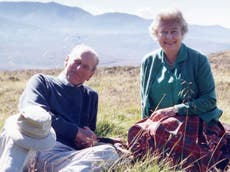European royal family tree: How Prince Philip and the Queen are related
Queen Elizabeth II and Prince Philip were both descendants of Queen Victoria
Your support helps us to tell the story
From reproductive rights to climate change to Big Tech, The Independent is on the ground when the story is developing. Whether it's investigating the financials of Elon Musk's pro-Trump PAC or producing our latest documentary, 'The A Word', which shines a light on the American women fighting for reproductive rights, we know how important it is to parse out the facts from the messaging.
At such a critical moment in US history, we need reporters on the ground. Your donation allows us to keep sending journalists to speak to both sides of the story.
The Independent is trusted by Americans across the entire political spectrum. And unlike many other quality news outlets, we choose not to lock Americans out of our reporting and analysis with paywalls. We believe quality journalism should be available to everyone, paid for by those who can afford it.
Your support makes all the difference.As condolences pour in for Prince Philip following his death at 99, people are reflecting on the longevity and strength of the marriage that he and Queen Elizabeth II shared for more than 70 years.
The couple married in 1947, however, they had known each other for much longer, having first met at the wedding of Princess Marina of Greece and Denmark and the Duke of Kent in 1934 when the Queen was just seven years old and Prince Philip was 12.
Despite their young ages, it was said by news outlets at the time that Elizabeth, who at that point was not meant to ascend to the throne, and Prince Philip, could make a suitable match.
In addition to the royal upbringings of the then-children, Elizabeth and Philip also happened to share a distant relative, as both are descendants of Queen Victoria.
The monarch and her husband are therefore distantly related, as both were the great-great-grandchildren of Queen Victoria and thus third cousins.
For Queen Elizabeth, the relation to Queen Victoria is through her father’s side. During Queen Victoria’s reign as the Queen of England from 1837 to 1901, she had nine children, four sons and five daughters, with her husband Prince Albert.
When Queen Victoria died, the couple’s eldest son, Prince Edward, ascended to the throne in 1901, before his second-eldest son, George, who is the Queen’s grandfather, succeeded him in 1910.
King George V’s reign lasted until 1936, at which point his son, the Queen’s father,George VI, became king.
Queen Elizabeth II became the monarch of the royal family following her father’s death in 1952.
Alternatively, Prince Philip, who was born on 10June 1921 on the Greek island of Corfu to Prince Andrew of Greece and Denmark and Princess Alice of Battenberg, is related to Queen Victoria through his mother’s side.
During her time on the throne, Queen Victoria gave birth to her second daughter, Princess Alice, in 1843.
Princess Alice marriedLudwig IV, the Grand Duke of Hesse, and together they had seven children, including their eldest child, Victoria, who would later marry her father’s cousin, Prince Louis of Battenburg, in 1884.
Victoria and Prince Louis gave birth to their first child, Princess Alice of Battenburg, who is Prince Philip’s mother, in 1885.
Prince Philip’s mother eventually marriedPrince Andrew of Greece and Denmark in 1903, before later giving birth to five children, including the Duke of Edinburgh, the couple’s youngest child and only son.
Queen Elizabeth, who had reportedly been set on marrying Prince Philip since she was 13, and the Duke of Edinburgh eventually reconnected in 1939, after she had become heir to the throne.
After a lengthy courtship, their engagement was announced on 8 July 1947, at which point the royal dropped his title as Prince of Greece and Denmark to take on the title of Duke of Edinburgh.
Prince Philip died on 9 April at home at Windsor Castle, with the royal family announcing his passing in a statement that read: “It is with deep sorrow that Her Majesty The Queen announces the death of her beloved husband, His Royal Highness The Prince Philip, Duke of Edinburgh.
“His Royal Highness passed away peacefully this morning at Windsor Castle. Further announcements will be made in due course. The Royal Family join with people around the world in mourning his loss.”






Join our commenting forum
Join thought-provoking conversations, follow other Independent readers and see their replies
Comments